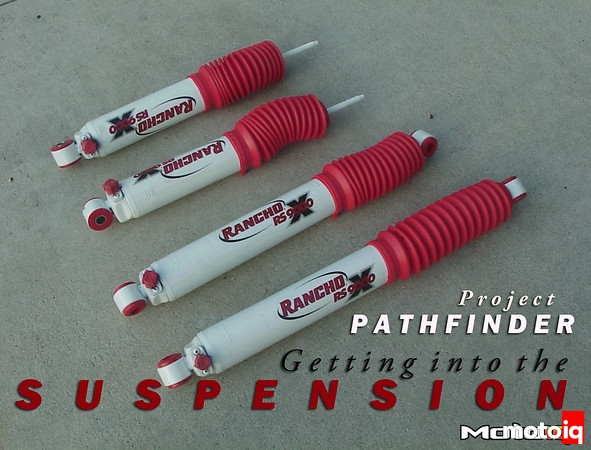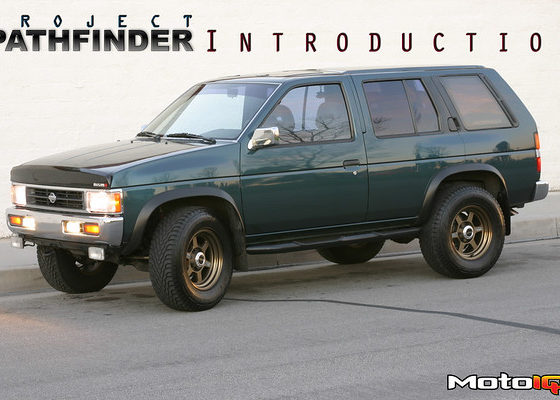
Project Pathfinder Part 3 Getting Into The Suspension
Project Pathfinder started off with a need, the need for an adequate tow vehicle for our SE-R cup racecar. We also wanted to make the vehicle a safer transport for everyone. In our last edition of Project Pathfinder we started off with some new trick wheels and tires to increase the amount of rubber on the road for grip, widen the track for stability and safety all without compromising off road handling. We also did some improvements to the brakes.
This month we tackle an area of serious deficient for most SUV’s, the suspension. We were faced with some tough decisions here. Since we use our Pathfinder for everything from daily commuting, to drives to the mountains hauling mountain bikes and gear to off road exploring, we had to come up with a reasonable compromise. Our main goal was not to build a car crushing monster truck or a Rubicon Trail bolder crawler but to greatly improve on-road handling, to eliminate the SUV characteristic of flipping over when pressed and to provide a safer ride when towing. We wanted all of this with improved off-road capability as well.
Towing was the big problem. When towing our racecar, the Pathfinder would rear up like it was doing a wheelie, the steering would get light and the car would wander around the road. In crosswinds driving straight was scarier than taking turn 9 at Big Willow balls out in the racecar! Part of the problem was the 120k mile stock suspension. The Stock SE suspension was mostly designed for a plush ride and good off road characteristics. It has soft spring rates and electronically adjustable shocks that can be adjusted for stiffness via a switch in the driver’s compartment. What once worked ok when new was now showing its age. You could barely tell the difference between touring and sport modes due to the worn shocks. Also the stock torsion bars had sagged and Project Pathfinder’s front suspension was sitting on the bumpstops with its back in the air like a old school hot rod. Due to the bottomed out suspension the ride was abysmal.
Rancho and Nissan Motorsports came to our aid with some fresh underpinnings for project Pathfinder. Since our suspension had to a have a large latitude of flexibility of use from mountain road corner carving to off road dirt antics, we chose Ranchos new 9 way adjustable RS9000X shocks.
 |
| Rancho RS9000X Shocks |
These shocks have a very wide range of damping adjustment from slightly firmer than stock to near racecar firm. The Rancho shocks feature a sophisticated 10-stage valve system with a triple tube construction to allow for extra valving stages between the tubes. One-way fluid flow helps keep the bubbles in the fluid confined to the outer tube. A cellular foam insert also helps keep the shocks internal gas necessary for shock shaft displacement volume under control for more consistent damping. The triple tube design makes the shocks less susceptible to rock denting that can take single tube shocks out of action. Most shocks are only twin tube. The Ranchos feature beefy internal construction with low friction bushings and a large 5/8” shock shaft. The 9 stages of damping adjustment are accomplished easily from an easy to reach external knob on the bottom of the shock body. Another plus is that the shocks can be converted to external adjustment from the drivers compartment with an easy to install optional kit. The Ranchos also feature firm and durable urethane shock bushings and red urethane boots to keep dirt and dust away from the seals.
 |
| 27.5mm diameter Torsion Bars |
Nissan Motorsports provided some heavy-duty torsion bars with a 30% higher spring rate for the front. The torsion bars are 27.5mm indiameter up form the stock 26mm. These bars are not designed to raise the truck but to firm it up to reduce bottoming in off road action and to reduce body roll on the road. We are only going to slightly raise Project Pathfinder from stock. Our idea is not to crate a monster truck or a bolder creeper but something like a rally car, which can take the dirt but still be competent under all conditions. In the rear we obtained some Nissan Motorsports rear springs. These springs raise the body by one and a half inches and are 30% stiffer. This should help correct our cars nose high attitude when towing. When really cranking on Project Pathfinder in the twisties, we noticed a somewhat nasty tendency to oversteer late in a turn.
 |
| Nissan Motorsports Front Swaybar |
We installed Nissan Motorsports front swaybar to reduce this tendency. It is also about 20% stiffer in roll than the stock swaybar. Its 26 mm in diameter up from the stock bars 25mm. It has urethane bushings and has fewer bends making it stiffer.
We installed the components, adjusting the torsion bars to raise Project Pathfinder’s nose 1 inch from stock gaining something like 4” in wheel travel from our previous sagged out state. With the 1.5” rear lift our rake was much like the Pathfinders stock nose down attitude. We gained about 3” of rear wheel travel over the sagged and worn stock springs. We experimented around and found that setting the Ranchos at 4 out of 9 in the front and 2 out of 9 in the rear gave a plus but very controlled ride. Project Pathfinders roll in the turns is greatly reduced and its bump soaking up capability is greatly increased by an order of magnitude. In offroad action Project Pathfinder can traverse rough roads better than our buddies 3” lifted Pro-Comp suspension equipped S10, much to our surprise. Our better suspension has brought more deficits in Project Pathfinders underpinnings to light. Our steering now feels loose and the response to steering input still feels poor. We will address these in future issues.
 |
| Swaybar Installed |
 |
| Torsion Bar Installed |
 |
| Rear Suspension Installed |
Stay tuned, in coming additions of Project Pathfinder we will continue in our quest for the ultimate suspension with more parts from Rancho, Energy Suspension, Spencer Low Racing and Automotive Customizers.
Sources


